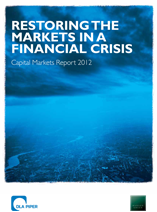Download this report
(PDF, 1.3MB)
Executive Summary
The feedback received from our contributors has been generous and wide-ranging and there are a number of important and interconnected themes which emerge. The following, in particular, appear to us to be fundamental to an effective restoration of market function.
The benefits of a truly diversified pattern of funding will only be possible if there is an improvement in the corporate sector’s awareness and understanding of the range of fundraising options at its disposal
Many companies see genuine benefit in maintaining a multi-faceted structure to the financing of their businesses. Nevertheless, the fundraising market is still characterised by a degree of imperfect information. Awareness of flexible and cost effective private placement products, for example, is relatively low in comparison with alternative financing routes.
The current IPO model will not be ‘fit for purpose’ until there is a more cooperative partnership between the participants at the centre of the process
Present concerns about market inertia in the UK have much to do with the perceived effectiveness of the IPO model itself, with the IPO being seen as the basic building block of market functionality, both in terms of profile for the markets themselves and as an assurance of quality of the issuers on the markets over the long term. The concerns focus most particularly on the way in which prices are set, the approach to bookbuilding and the quality of the relationships that exist between the stakeholders involved in the successful completion of an IPO. There are areas in which the processes and techniques which have developed over time have not necessarily represented an improvement over their predecessors. In some cases at least, “original” might also have been “best”.
The current ‘trust deficit’ within the commercial environment at large is an intangible yet highly potent factor contributing to market disharmony. It may create an opportunity for ‘advisory only’ houses to play an expanded role, particularly if they succeed in providing a more tangible demonstration of their value proposition
Depending on the circumstances of the issuer and the specific structure of the offering, ‘advisory only’ institutions may have a valuable role to play within the capital markets arena. If the apparent ‘trust deficit’ within the business environment persists, it is conceivable that corporate decision-makers will increasingly consider turning to advisory only houses to provide the genuine level of independent thinking and objectivity of guidance which they currently seek from their professional service providers.
The financial regulatory regime may continue to fail to deliver optimally, unless it achieves a more effective balance between a ‘top down’ and ‘bottom up’ approach
The regulatory regime in the UK is no longer acknowledged to be ‘state of the art’. This might be, in part, an issue of communication and the level of understanding of the regulatory approach. However, a key reason why the regime has not delivered as effectively as commentators and stakeholders would expect of it, may be due to its emphasis to date on a ‘top down’ approach, focused on the size, status and capital structure of institutions. There has been a perceived comparative lack of focus on a ‘bottom up’ approach which seeks to foster and optimise the interactive behaviour between individual market participants.
The London markets have a viable future, regardless of whether the London Stock Exchange completes a merger. The London Stock Exchange brand is in many ways a mirror which reflects the conduct of market stakeholders. Those stakeholders must acknowledge responsibility for enhancing, defending and nurturing that brand and for improving the clarity of communication with key participant groups
The LSE continues to be essential to the UK financial markets, as well as to the maintenance of London as a key financial centre. However, the London market proposition has been challenged over time by the volume of new entrants being prioritised at the expense of an appropriate level of control on the quality of those companies. Responsibility for maintaining the quality proposition is collective. It lies principally in the hands of the market participants, including the advisory community. The brand of the London markets in general, and of the LSE in particular, is to a large extent reflective of the degree to which that responsibility has been discharged.
Optimising the corporate governance framework requires a greater focus on the relationship between board composition and value enhancement. For an effective board, merely re-balancing the risk/reward equation for directors will not in itself be sufficient
Executive directors, non-executives and advisors alike are increasingly recognising the beneficial impact that intelligent and relevant corporate governance can have on the perceived quality of a business. With that in mind, it has become fashionable to focus on the balance between risk and reward for directors, particularly non-executives where what was historically seen as a ‘lite’ route to board participation is now understood to require fuller attention and focus from those involved, together with a greater commitment of time. Although that is clearly relevant in attracting talent, our respondents indicate that the key factors determining the quality of corporate governance relate primarily to board composition. There is strong demand for board composition to be focused on generating tangible value and not just delivering diversity for diversity’s sake.
